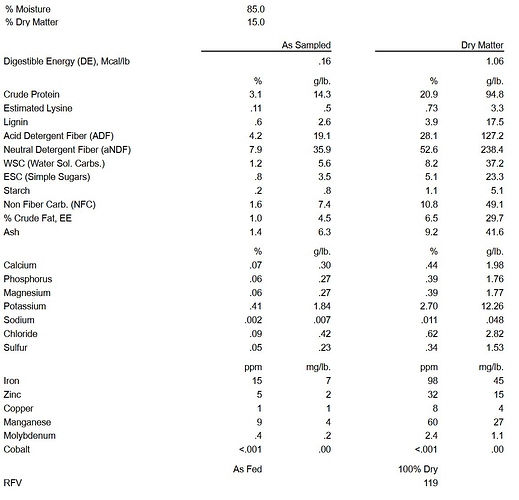For hay, you look at the As Sampled column, and for grass you look at the Dry Matter column
It’s not exact, you’d have to do a bit of conversion to take into account the moisture level, but it’s close enough here
So, on a DM basis, WSC + starch is 8.2% + 1.1% = 9.3%, which is < the desired 10% and also the starch is < the max 4%
As is typical, copper and zinc are low, only 88mg Cu for an 1100lb horse eating 22lb, when he needs at the very minimun 100mg. Zn is only 330mg compared to the min 400mg required
As is also typical of grasses, the Ca:P ratio is low, only 1.12:1, when it needs to be at least 1.5:1.
A good ration balancer will cover these bases well.
A forage balancer is also going to cover the cu/zn issue, but most don’t contain any Ca or P. The only 2 I know of (there may be some more, I just don’t know them) that have useful amounts of Ca and P, are Omniety Premix, and Amino Trace, BUT, AT has more P than Ca, so nto suitable for most grass forages, for the reason seen here which is very typical of grasses.
As long as the balancer you’re using is fed according to her ideal weight, then it’s covering at least her minimum bases. If you have coat and/or hoof issues (excessive bleaching, cracking, skin crud) I’d add additional cu and zn.
A big question here is - what time of day did you grab the sample, what were the conditions like the day and night before, and day of? If you grabbed early in the morning after a nice warm night, sugars will be lower than if you grab at the end of the day. If you grabbed at the end of a cloudy day, after a warm night and cloudy day, sugars will be lower than if any sun was involved.
This is what makes analyzing pasture for the purpose of sugars tricky.
So yes, I would blame the pasture, despite this analysis, since sugar levels vary through the day.

